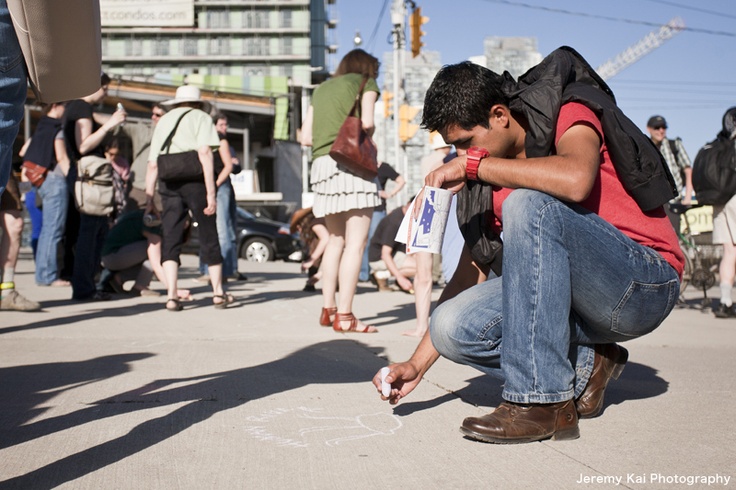
Jane’s Walk, moving neighbors to build better cities
Jane’s Walk 2013: Toronto, Ontario, Canada – “Garrison Creek Part 2: Planting Our Feet and Ears to the Ground” – Guided by Members of Homegrown National Park. Photo credit: Jeremy Kai.
Denise Pinto is the Global Director of Jane’s Walk, a charitable project of Tides Canada. Below, she writes about the project’s efforts to develop new programming initiatives with the support of the Knight Foundation and in Partnership with the Municipal Art Society, creating greater opportunities for civic engagement and city-building in locales around the world.
If you happened to be in Metlika, a small medieval city in Slovenia, on the first weekend in May last year, you might have bumped into a group of people of varying ages navigating the narrow streets together. With their focus directed on places for youth to hang out, this little assembly of residents would — like many groups around the world — be touring their neighbourhood in an effort to draw together common insights about the life of the street. If you struck up a conversation with one of them, they would have said they were on a Jane’s Walk.
People often ask me what is Jane’s Walk and what do we aspire to do?
Jane’s Walk is, first and foremost, a method of social convening. It’s a global movement of people of every age, ability and income level, getting together to explore their cities on foot by inventing short walking tours to share with their neighbours. Hallmarked by a festival on the first weekend of May, the movement was created in 2007 by friends of Jane Jacobs (1916-2006), to celebrate the iconic writer and urban activist’s life and ideas. Jacobs wrote that “cities have the capability of providing something for everybody, only because, and only when, they are created by everybody.” It is so important that we are all involved in the discussion of good city-building. We ask everybody to participate: children, politicians, shop owners and dog-walkers. It’s a grassroots movement in the truest sense. The festival gives people a chance to share their ideas about the city, meet their neighbours and develop dialogue. Although Jacobs had no formal training as a planner, her 1961 treatise The Death and Life of Great American Cities, introduced me and many others to ground-breaking ideas about how cities function, evolve and fail that now seem like common sense. When I was brought on as director of Jane’s Walk last year, I was honoured to be part of a movement that realizes Jacobs’ philosophies about sidewalks, parks, retail design and self-organization. These ideas guided my previous work as a landscape architect and inspired me to become an active member of my community in Toronto. Over the better part of a decade, hundreds of thousands of people have come together in her spirit, to walk and talk about their perspectives in over 100 locales around the world. Having personally participated in many walks, I am always struck by how unique each walk is and how it prompts the revelation of unlikely stories and civic champions. Petra Vertelj Nared, one of the participants in Metlika, for example, wrote the following account of their walk for our inaugural Jane’s Walk book: One of the participants, who had once been a student in the primary school, pointed out that what had been missing in her school days was an outdoor classroom. Such a classroom, she said, could encourage the students to go outside more and would offer a cozy environment for learning and socializing. Some participants also suggested that the local Mladinski Centre (youth centre) which offers social and cultural events should hold activities outdoors, perhaps in a nearby park. This would stimulate the use of public space and park maintenance efforts. Given that walkers were accompanied by the deputy mayor and members of the cultural society KUD Plac, there is reason to hope that these ideas for change will be realized in the near future. The heroic efforts of the thousands of volunteers that pull together the annual Jane’s Walk festival is a true testament to Jane Jacobs’ life’s work. In May 2013, there were more than 800 walks that took place across five continents. With all this organic growth, we’ve reached a moment where the lessons of one city can seed new conversations in another. How do we connect people across distances? Perhaps by creating smaller Jane’s Walk events throughout the year, or by inviting our host of wonderful and motivated partner organizations to invite new cities into the fold. With the support of the Knight Foundation, Jane’s Walk is launching Murmur to Movement. This program will build upon the festival, using an interactive web platform to promote best practices, foster innovative ideas and facilitate mentor networks between cities adopting Jane’s Walk for the first time. Jane’s Walk will also be collaborating closely with Municipal Art Society (MAS), a civic organization with a long history leading community building initiatives, and an early host of the Jane’s Walk festival. With input from MAS, Jane’s Walk will develop and execute new workshops, toolkits and webinars to support a pilot group of cities in the U.S. from Akron to San Jose. These cities will help co-create a new support system for organizers around the world who want to champion urban literacy.
The Jane’s Walk festival this year will take place on May 2, 3, and 4. The international project office, in collaboration with the Knight Foundation and MAS, look forward to working with new cities to support and organize walks. If you are interested in having your city participate as part of the Murmur to Movement program or would like to learn more, visit www.janeswalk.org.
Recent Content
-
Community Impactarticle ·
-
Community Impactarticle ·
-
Community Impactarticle ·


